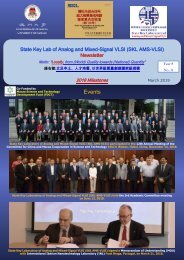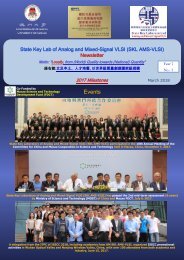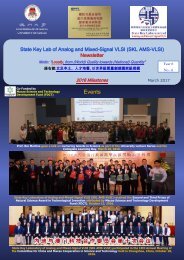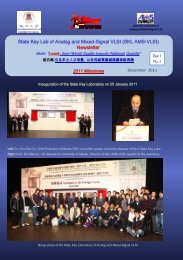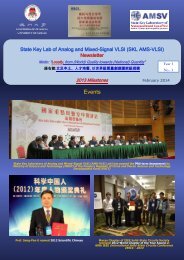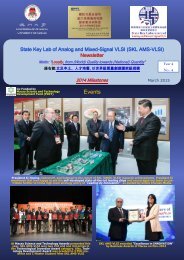AMSV Newsletter 2015
AMSV Newsletter 2015
AMSV Newsletter 2015
Create successful ePaper yourself
Turn your PDF publications into a flip-book with our unique Google optimized e-Paper software.
A 6 b 5 GS/s 4 Interleaved 3 b/Cycle SAR ADC<br />
In ISSCC <strong>2015</strong> & JSSC 2016<br />
Chi-Hang Chan, Yan Zhu, Sai-Weng Sin, Seng-Pan (Ben) U, and Rui Paulo Martins<br />
From Data Conversion and Signal Processing research line<br />
Motivation<br />
Architecture<br />
For 60GHz-band receivers and serial links applications.<br />
The SAR ADC is a well-known energy-efficient architecture<br />
while the speed of SAR ADCs can be further improved<br />
with the comparator interleaving, loop-unrolled<br />
asynchronous loop or the multi-bit per cycle.<br />
The Flash ADC is known as the fastest ADC architecture<br />
but power hungry. By adopting interpolation or calibration,<br />
outstanding energy efficiency can also be accomplished<br />
under advanced technology nodes.<br />
In a standalone flash or SAR architecture, speed and<br />
energy efficiency are still limited due to their inherent<br />
characteristics; therefore, they are often combined with<br />
time interleaving to achieve a breakthrough.<br />
Time interleaving can be a very effective way to increase<br />
the sampling rate of the ADC but it induces extra design<br />
complexity and conversion non-idealities especially with<br />
large numbers of interleaving channels.<br />
V in,P<br />
V in,N<br />
Input<br />
4<br />
En, chX<br />
4×<br />
Channels<br />
Clock<br />
Gen.<br />
Common<br />
Clk<br />
Bootstrap<br />
2<br />
V ref,N/V ref,P<br />
Decoder & BDCO<br />
3b/cycle SAR<br />
Segmentation Logic<br />
8<br />
DAC Array<br />
DAC Array<br />
DAC Array<br />
DAC Array<br />
Dummy Latch<br />
Dynamic<br />
Pre-amp.<br />
interpolation<br />
Latch<br />
Latch<br />
Latch<br />
Latch<br />
Latch<br />
Latch<br />
Latch<br />
Latch<br />
On-Chip Offset Calibration Cal Ctrl.<br />
6<br />
14<br />
6<br />
MUX<br />
Final Output<br />
Codes<br />
The power required for the digital gain and timing corrections<br />
is prohibitive at 6b resolution.<br />
Implementation<br />
Verification<br />
40<br />
30<br />
20<br />
10<br />
0<br />
SNDR/SFDR (dB)50<br />
43.5<br />
30.78<br />
SFDR<br />
SNDR @Nyquist<br />
43.12<br />
30.76<br />
42.95<br />
30.66<br />
1 2 3<br />
#Sample<br />
Sample #2, fs = 5 Gs/s<br />
45<br />
SNDR/SFDR (dB)<br />
40<br />
35<br />
30<br />
25<br />
SFDR<br />
SNDR<br />
20<br />
0 0.5 1.0 1.5 2.0 2.5 3.0<br />
Input Frequency (GHz)<br />
ISSCC’10[1] VLSI’13[5] VLSI’12[6] ISSCC’14[25] A-SSCC’14[26] This work<br />
Architecture Ti-pipelined B-S Flash Flash Ti-SAR Ti-SAR Ti-Multi-bit SAR<br />
Process 40nm 32nm SOI 40nm 28nm UTBB FDSOI 32nm SOI<br />
65nm<br />
Supply voltage (V) 1.1 0.85 1.1 1.0<br />
1.1 1.0 1.2<br />
10<br />
36<br />
5 6<br />
Sampling rate (GS/s) 2.2 5<br />
3<br />
Resolution (bit) 6 6<br />
Power (mW) 2.6 11<br />
SNDRminin Nyq. band (dB) 29.6 33.1<br />
Input cap.(fF) 200 72<br />
FoM@ Nyq.(fJ/conv.-step) 40.0 100.48<br />
Active area (mm 2 ) * 0.03 * 0.02 * 0.021<br />
Calibration<br />
Off-chip Off-chip Off-chip<br />
*without Calibration **with Calibration<br />
6 6<br />
6<br />
6<br />
8.5 32<br />
110 5.5 10.6<br />
30.9 33.8<br />
31.6 30.25 30.13<br />
135 100<br />
N/A<br />
31<br />
59.33 81<br />
98<br />
39 67.37<br />
* 0.009 ** 0.048 * 0.008 (**<br />
0.09)<br />
Off-chip On-chip<br />
On-chip




